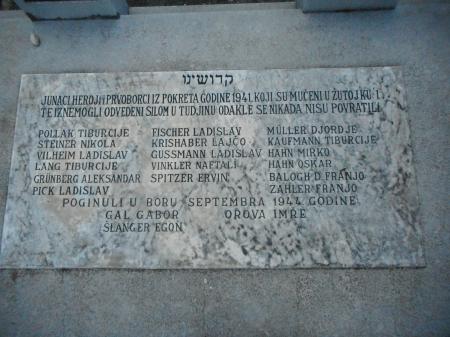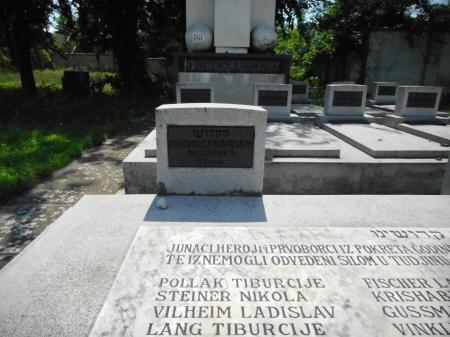Obj. ID: 50138
Jewish Funerary Art Mass Grave of the Twenty Martyrs from Bors in the Jewish Cemetery in Subotica, Serbia, 1948
To the main object: Holocaust Memorial Complex in the Jewish cemetery in Subotica, Serbia, 1948

Memorial Name
No official name
Who is Comemmorated?
Twenty Subotican Jews imprisoned in the Bor mine and Murdered in Crvenka in 1944.
Description
The memorial headstone of the mass grave consists of a horizontally placed slab, with a commemorative plaque bearing an inscription in Hebrew and Serbo-Croatian. Adjacent to the plaque are two vertical stelae. They are identical rectangular shapes and sizes, made of marble with granite memorial plaques. On the one on the left side are Hebrew and Serbo-Croatian inscriptions. The one on the right-hand side is an individual grave of Stevan Engler.
Inscription
On the Main Plaque
Hebrew
קדושינו
Translation: Our martyrs
Serbo-Croatian:
Junaci heroji i prvoborci iz pokreta godine 1941. koji su mučeni u Žutoj kući
te iznemogli odvedesni silom u tudjinu odakle se nikada nisu povratili
[Names of 17 Victims]
Poginuli u Boru septembra 1944. godine:
[Names of 3 Victims]
Translation: Heroic brave men and pioneers of the movement of 1941 who were tortured in the Yellow House and, exhausted, were taken by force to a strange country from where they never returned. / [Names of 17 Victims] / Killed in Bor in September 1944: / [Names of 3 Victims]
On the left-hand stele
Hebrew
הקדוש
Translation: The Martyr
Serbo-Croatian
20 jevrejskih borskih mučenika
1944. godine.
Translation: 20 Jewish martyrs of Bor, 1944.
On the right-hand stele
Hebrew
הקדוש
Translation: The Martyr
Serbo-Croatian
Engler Stevan 1921-1944. Bor
Translation: Engler Stevan, 1921 - 1944, Bor.
Commissioned by
The Jewish Community of Subotica
sub-set tree:
Marble
Granite (Black)
A total of 6,000 Jews from Hungary were conscripted as forced laborers at the Bor mine camp, including roughly 600 Jews from Bačka. Jewish prisoners were taken on death marches in September 1944. In a brickyard in Crvenka, near Sombor, over 1,200 of them were shot and killed.
At the first postwar conference of the Jewish communities in Yugoslavia, held in 1947, a demand for an urgent exhumation and appropriate burial of the victims was made. The report stated that the bodies had started resurfacing from the shallow mass grave in which they had been buried.
The monument was unveiled on September 5, 1948.
Commemoration ceremonies are held every year marking the anniversary of the deportation of the Subotica Jews on June 16, 1944.
Duranci, Bela and Vera Gabrić Počuča, Javni spomenici opštine Subotica, (Subotica: Međuopštinski zavod za zaštitu spomenika kulture, 2001)
"Memorials in Subotica,” Locations (Vojvodina Holocaust Memorials Project), https://www.vhmproject.org/en-US/Locations/Memorials/22 (accessed June 28, 2023)
Stipić, Davor, ''U borbi protiv zaborava: Jevrejska zajednica u Jugoslaviji i očuvanje sećanja na Holokaust 1945-1955,'' Godišnjak za društvenu istoriju 2 (2016), pp. 91-121.
“Jevrejsko groblje Subotica” Jevrejska opština Subotica, http://groblje.josu.rs/pretrazi-groblje/ (accessed June 28, 2023)


















